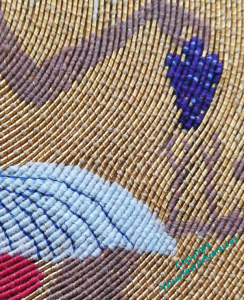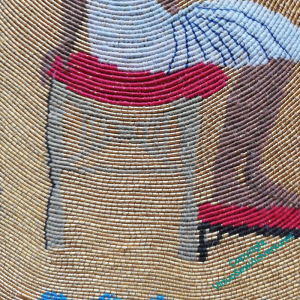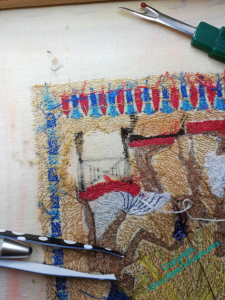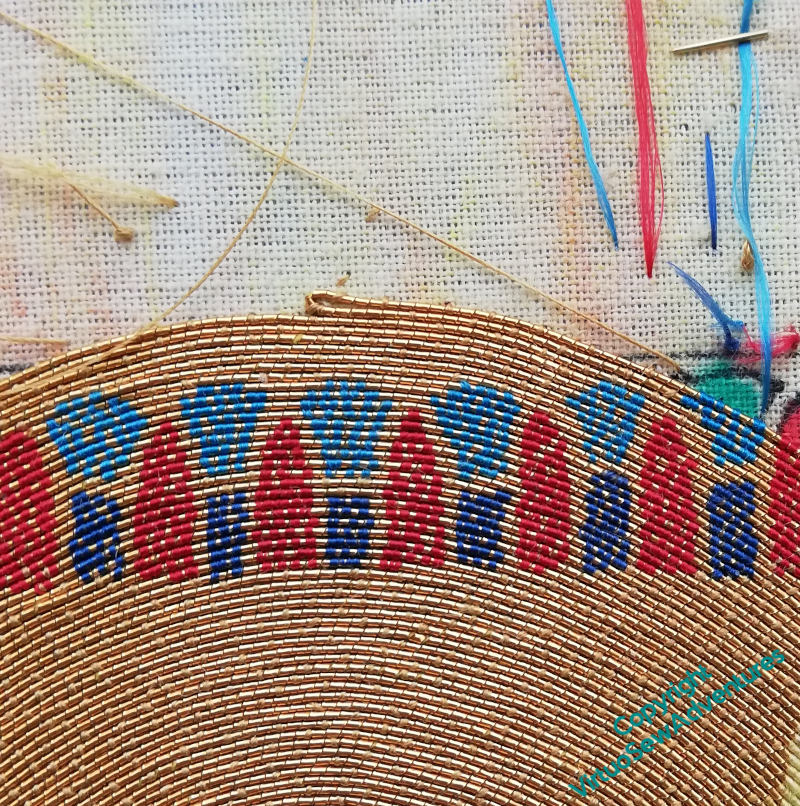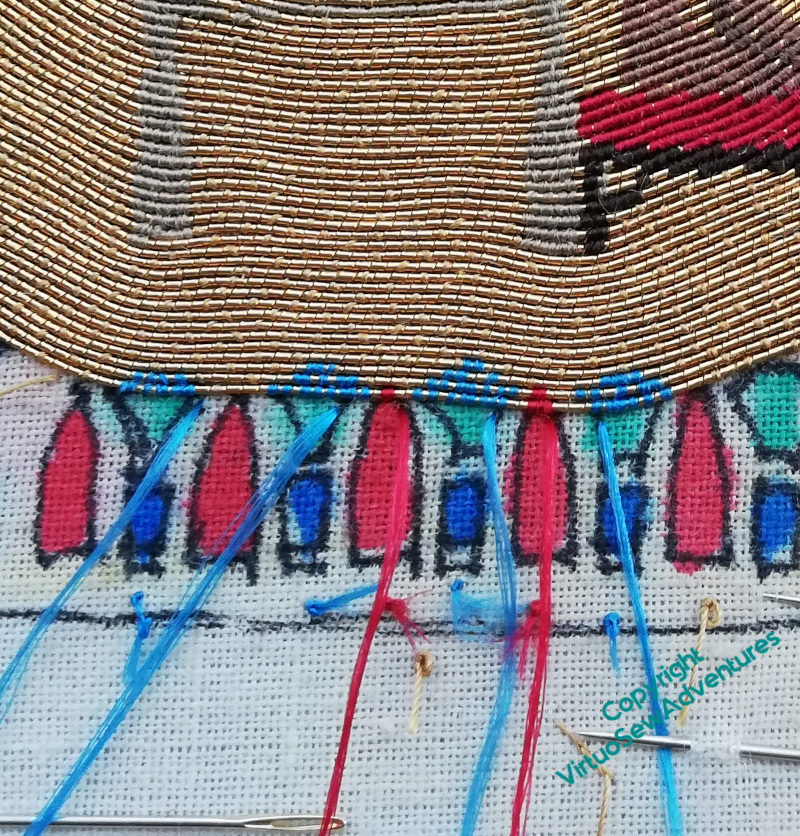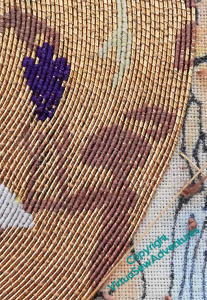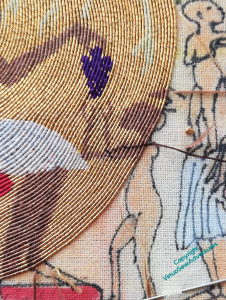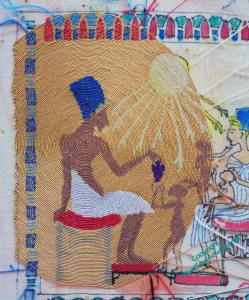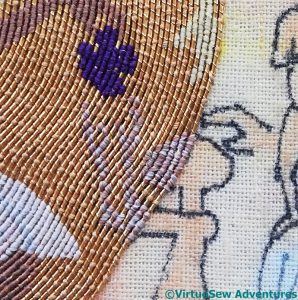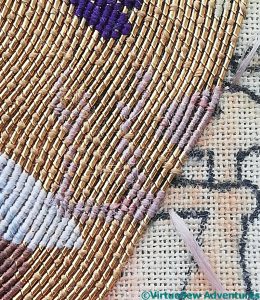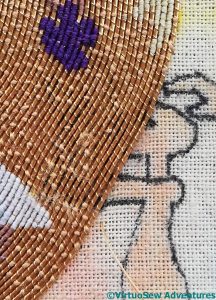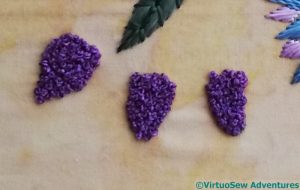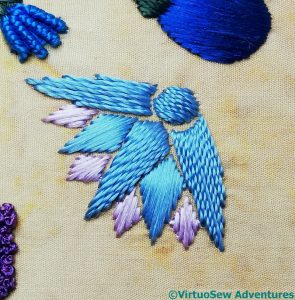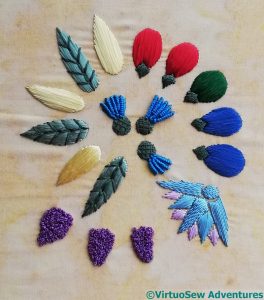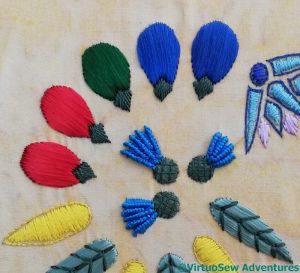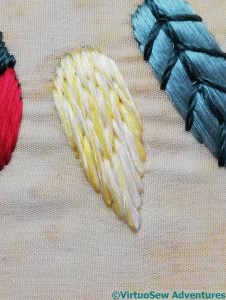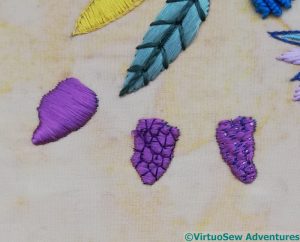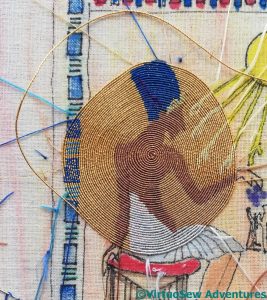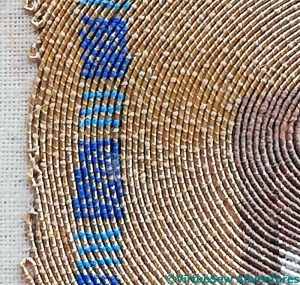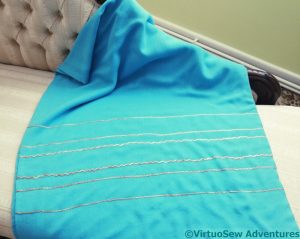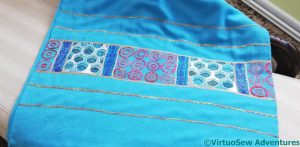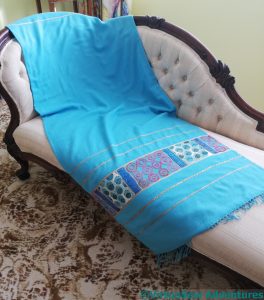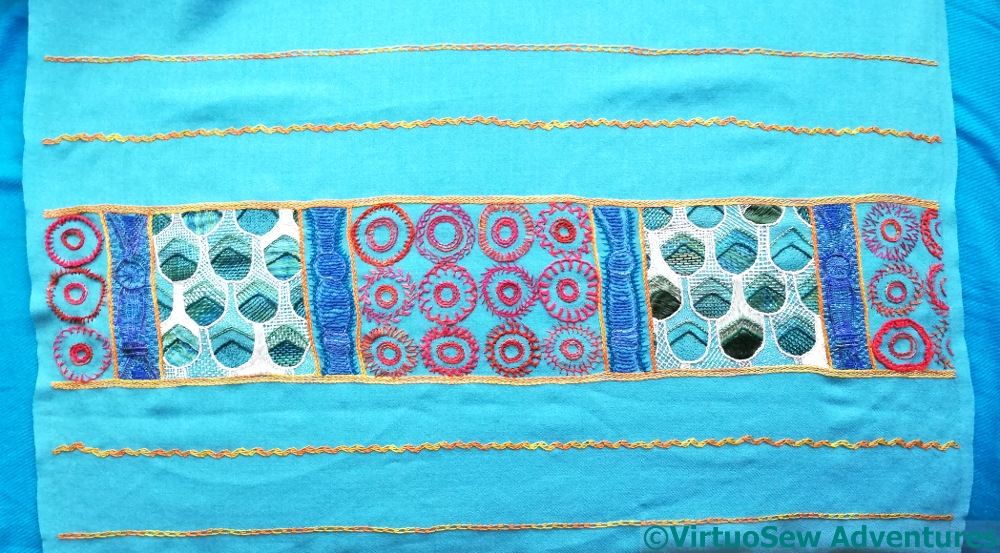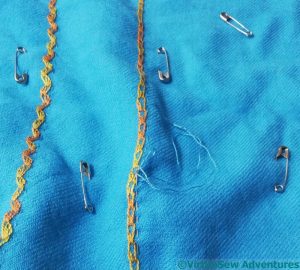Category: Dreams of Amarna
Adding details to the Amarna Family Group
It has been some time since I reported on the Amarna Family Group, and that is partly because, when I had finished the basic design, I was more than a litttle uncertain how much detail I wanted to add, and quite frankly, I was a little unnerved by the mere idea of adding any detail at all!
However, eventually, I gathered my courage in both hands, and started to make an attempt. First, a few lighter and darker purple stitches on the grapes – I may decide to add more, but I don’t want the details to overwhelm the design.
And this is the point at which I went astray. Whitening the kilt with dark lines for the creases and additional white stitches was rather difficult and stressful, so I moved on to tackle the seat. I tried to add enough details to bring the seat to life and pull it away from the background, but instead found it too detailed, too fussy, drawing the eye away from the warmth of the family group and emphasizing the furniture. Not at all what I wanted.
I left it alone overnight, hoping that it would settle together and I would see it with a clearer eye.
It didn’t settle together, and I did see it with a clearer eye. I was so frustrated and upset, I didn’t stop to take a picture, but sat down, picked up scissors, stitch ripper, tweezers, and a blunt tapestry needle, and unpicked it.
It took all day.
That was some time ago, so Episode 50 of SlowTV Stitchery is about Something Else Entirely. A fishy experiment is introduced and there are some musings on the blending of threads.
More Progress, Amarna Family Group
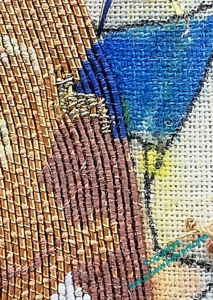
As I kept on with the little girls, of course, I kept on with Nefertiti, and eventually tackled the famous profile, which worked better than I feared, although I will admit that the lighting here doesn’t let the skin colour show as much against the gold as it does in real life. Next was the gold uraeus on the headdress, which, as I commented when I worked Akhenaten’s uraeus, does feel rather “peak Ancient Egypt” in the use of gold to hold down gold! Still, the royal blue against the golds is enough to make the heart sing.
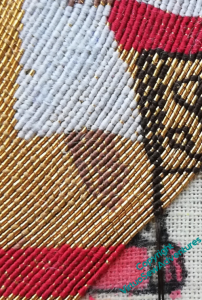
You can see here that the blue in Nefertiti’s skirt has been replaced – all but one stitch, which I will have to deal with in the “details” phase of this one – the list for which is getting increasingly full of anxieties!
Nefertiti’s feet were among the anxieties, but as you can see from this photo, just leaving them right to the end was increasingly untenable, in spite of the stool leg and the foot cushion to anchor the gold threads.
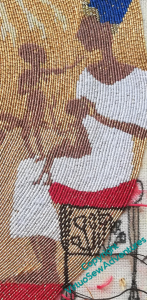
However, the difficulty of working them starting away from the rest of the body was also considerable, and I do think I made the right decision in waiting until I could start from the legs!
I’m still not sure whether I will fill in some of the sections of the stool Nefertiti is sitting on. At the moment, it looks strong, but it doesn’t separate itself from the background as much as perhaps it should, especially as the figures are looking so striking. I don’t want Nefertiti to look as though she’s sitting on air!
Episode 28 of Slow TV Stitchery is now live, and it considers the post mortem reputations of kings, the perils of scarifying a lawn, and the expertise of the laundries of Amarna.
More on the Amarna Family Group
So, edges. Obviously, with the straight version of this technique, the edges are simple – either every single one is plunged, or maybe every other one, if the threads are used doubled. I have a strong aversion to plunging threads, I hate waste, and I just couldn’t face the tangles I experienced when I was working on Christus Natus Est.
So the edges of this piece are being done simply by turning the thread back on itself. I will, of course, have to cut the thread to fill in the corners, but that’s much less fuss, and I am intending to oversew each end very firmly, and not plunge the threads at all.
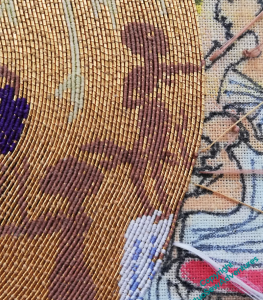
I began on Nefertiti’s dress intending to do something like I’d done with the pleats on Akhenaten’s kilt, but making the lines more definite.
Having started, though, I decided it wasn’t at all satisfactory. Whether it was the wrong colour, the wrong resolution (not that I can make the lines any narrower!), or simply not simple and crisp enough, I’m not sure. I was sure that it needed to come out.
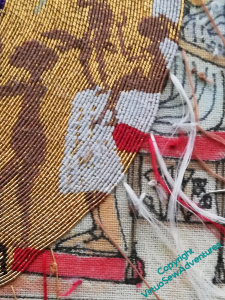
So that’s what I did.
Unpicking is really not fun, and some of the white silk fell victim to my unpicker, so the raggy bits had to be eased to the back and tidied up before I could even think about reinstating the white.
Notice, however, that the little girls are making pretty good sense just as they are!
The next episode of Slow TV Stitchery is up – Episode 24 – which covers Looking ahead to The Next Epic Project, lessons from the Impressionists, and the trick of making a design’s evolution look “meant”. Do go and have a look!
Amarna Family Group Progress
In the end, I sighed, consigned the Cretan memories to perdition, and decided to do the little girls in the same colour as their parents. However, while I was looking at the tangle of limbs and bodies of the two smaller girls on Nefertiti’s lap, I thought that something definite would need to be done to keep them from turning into an amorphous tangle of limbs, something like one of my early memories of my two big cousins. I’ve since got my cousins separated in my head, but I thought it would be nice to keep Nefertiti’s daughters individual from the start!
So I started putting in an outline on the eldest daughter, using a fine, very dark brown thread from Devere Yarns.
Only to stare at it with hostility, because it somehow managed to look a bit too clunky!
Considering that Devere silks are really very fine, this is quite an achievement, although I’ll admit it wasn’t one I particularly cherish.
So I decided to just keep working on the “block colours” of the design and trust to later inspiration to find out how to keep the girls from blurring into an undifferentiated shape. I’ve left a few deliberate gaps where limbs cross, to help the design “read” properly.
And I’m not sure, now, that they really need anything else…
The video is well in advance of these posts, because I lost the photos I was going to use. Heigh-ho. Anyway, enjoy Episode Twenty Two, in which, among other matters, the mathematical concept of “triviality” is discussed…!
More on the Amarna Family Group
While I was stitching round and round in circles, I was also thinking about the rest of the design, and about what else it might be showing.
I had a thought that it might be nice to make a reference to the Cretan art that was so influential for the art of the Amarna period. One of the conventions of the art of ancient Crete was that women were depicted as light-skinned, while the men were shown as tanned, so I thought I would give that a little twist, and work the three daughters as light-skinned, and Akhenaten and Nefertiti as tanned, thus “bookending” the scene.
So I blended a lighter colour and got started on Daughter Number 1.
Only to decide I really didn’t like it, order some more flat silk, and try again. This is the lighter shade of Akhenaten’s skin colour, and as you can see, it is too light. It barely shows against the gold, and at that, the photo shows it better than it showed in real life – I had real trouble seeing it to stitch.
So that wouldn’t do, would it?
The next thing I tried was a blend of the light and dark skintones, and as you can see, there isn’t even a photo of that!
Sigh.
Unpicked again.
The videos are of course somewhat beyond this point – Episode 16 – “On the satisfaction of pattern building and the avoidance of confusion” is now available. Do have a look!
Finishing the Faience Necklace
In the end, I unpicked both of the previous attempts, and used a mass of French knots, worked again in hand twisted silk, this time combining some of the very fine silk from a Frostings box with my Japanese Flat silk.
I think these work well, especially at the small scale of the piece.
I’d been rather dreading the large lotus flower, representing the shaped endpieces of a broad collar necklace, because I was remembering the struggle I’d had with the “Fragment of Tile That Started It All“.
Then I had an epiphany of my own, and used the difference in appearance and reflectance of twisted silk compared with flat silk to help distinguish the shapes of the petals and bring the foremost ones forwards. I’m very pleased with how that turned out!
And now, finally, it’s done!
This one is almost certainly going to be one of the “spots” around one of the big panels, because although I like it, and it represents what I want it to, I don’t think it has the visual strength to stand alone.
But then, if all the pieces could stand on their own, I wouldn’t be able to assemble the panels I want to, would I!
Finally, Episode 14 of SlowTV Stitchery is now live, discussing design thoughts, music and musicians. Do drop in and see how I’m getting on!
Steps forward, steps back
The necklace description that Mary Chubb was asked to transcribe, after her epiphany in the cellar, includes a row of dates in a repeating colour pattern of two red, one green, two blue.
So here they are, in satin stitch in flat silk for the main fruit, and more satin stitch, but this time using hand-twisted threads, for the stem. I found a rich and vibrant green for the main green fruit and used a greyish-green for the stem. Again, I’m trying to balance echoing the faience with echoing the real fruits, leaves and flowers, which is making for some interesting puzzles!
I wanted to try blending the silk filaments for one of the elements, to help recall the slightly iridescent effect of some glazes, and spent a wonderfully painstaking (exasperating!) afternoon splitting my silk. And then recombining it, and using it to stitch the first of the lotus petals in long-and-short stitch.
Only to sit back and glare at it. It’s looking congested, chunky, and not at all what I was looking for. What’s more, it’s buckling the fabric in spite of the calico support.
Snip, snip, out it comes, and now I need to think again.
Meanwhile I have another element to think about as well. You can see the underlayer of satin stitch on the shapes which are supposed to be recollections of bunches of grapes, and then two attempts to give them a more defined appearance. I think I prefer the middle version, which was the second I did.
That, however, means I have to unpick my first attempt. Sigh.
There was a problem with uploading my video last week, so here it is, somewhat delayed: Episode 10 of SlowTVStitchery. And, just so we don’t get too far behind ourselves: Episode 11 as well!
Amarna Family Group
I recall from both the Hittite Amulet and Christus Natus Est that Or Nué projects are rather difficult to write about. They’re a little like those novels in which Nothing Happens, because one edges slowly forward, with the piece growing imperceptibly – until all of a sudden, it gallops to a conclusion. I am nowhere near that point as yet, but for the benefit of those who prefer reading to watching, I will attempt to provide occasional updates…
Here is one of the progress shots.
There are a few details I will have to come back to, as you will see if you click through to the larger image. I may have to adjust Akhenaten’s arm, for a start, and the pale blue I used to mark the creases on his kilt isn’t dark enough to do the job, so I will have to do find another thread and add some stitches.
However, the metal thread on the front of Akhenaten’s headdress shows up rather better than I feared it might. Although, as I said on one of the videos, gold thread couched with gold thread is pretty much Peak Ancient Egypt. Even Louis XIV, never an advocate of moderation in design, would take a step back, crying, “Here, I say, steady on!”
To which I reply, I am steadying on – it’s staying in!
This is a close up from slightly more recently. You can see that I’ve reached the designated edge of the design, and that rather than cutting and plunging my threads, I’m doubling back on myself, so all the gold remains on the surface. My intention is that this will be edged with some sort of braid when it is complete, and attaching a braid through the gold as it stands will be quite hard enough, without attaching it through plunged ends as well!
I’m also leaving the royal blue blocks in a sort of half-tone, with some of the gold showing through. I may decide, when the whole thing is finished, that the border designs need to be full strength if they are to frame the scene properly, but I felt that this might work, and would be an interesting experiment.
But, occasional reservations aside, I think this is going to be a very successful piece!
Finally, completely finished!
More progress on SlowTVStitchery – Episode Eight is now up. It contains intimations of dilemmas to come… Enjoy!
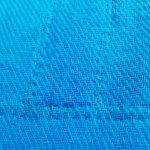
After washing the pashmina for the lining several times (it dyed the water bright turquoise the first three times at least, with no discernible fading in the fabric), ironing both of them, and pinning them together with safety pins, I settled down with my turquoise silk thread and ran simple running stitch quilting along all the gold lines of the design. This was easiest to do, I found, by cutting the thread to a little over the width of the pashmina and starting in the middle of both the thread and the shawl. Once the main lines were in place, I went back to the polychrome band and added the extra lines of stitching to delineate the frame.
It’s not easy to see, although I’ve done my best with this photo, but I’ve worked several rows of variegated golden lines across the pashmina on the otherwise undecorated end. I felt, when I finished the polychrome band that the whole thing looked a little unbalanced, and needed something to prevent the impression of something just fading out. I used Wavy Chain, Shell Chain, and Cable Chain, which are used on the other end, too.
And here is the polychrome band. You can see that the proportions aren’t quite perfect, but it is very much in the spirit of the StitchOff that the pashmina was originally bought for, in that it is intended to be worn and enjoyed, not stuck up on a wall. It wasn’t quick to do, but that is the fault of my own talent for over complication!
At long last, the Nefertiti Shawl is finished and lined, the lining has been controlled with lines of stitching, and the whole thing has been pressed. It should be seriously cosy – the lining is another cashmere pashmina, and it clings slightly as I wrap it around myself. It’s not an easy piece to photograph, hence the languorous drape over the sofa!
Last details on the Nefertiti Shawl
Well, at last!
As you can see, I didn’t perfectly centre my sketch of the design when I put it on the pashmina, but once it’s swept around my shoulders, I doubt very much whether anyone will notice!
I’ve also put a narrower set of gold lines on the other end. I didn’t want to work the whole thing again, but I felt that a little extra colour would nevertheless help to make the whole this look a bit more thought-out. Or at least, more completely evolved!
However, I did decide that in the interests of not spending all my time on maintenance, I was going to line it, and I found another turquoise blue pashmina with which to do so. It is slightly narrower (so I turned in the selvedges of the embroidered one to meet it), slightly longer, and doesn’t have a fringe. So I could line just the fabric length, and cut off the excess.
How to control the fabrics while I was doing so gave me a little trouble, until I remembered seeing quilters use safety pins to “tack” fabrics together. That worked beautifully!
I spent a couple of evenings working running lines beside each of the gold lines. Just straight running stitch – in the case of Wavy Chain, I simply offset the line a little, rather than trying to follow the zigzags.
SlowTV Stitchery continues – Episode Four and Episode Five are both now up to view. Enjoy!

